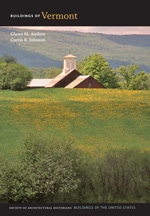
The Classic Cottage house form, essentially an evolved one-and-a-half-story, wood-frame, Cape house built with two stove chimneys, became popular in rural Vermont in the 1830s and 1840s with the Greek Revival. By 1870, side-hall and tri-gable-plan houses with Victorian styling filled many streets in the railroad villages, but the Classic Cottage remained popular in agricultural districts through the end of the decade. The house that Moses LeFevre built for himself is illustrative of the local evolution of the form among upland farms on the western slope of the Green Mountains. LeFevre is credited with a half dozen other Greek Revival Classic Cottages and two-story, central-hall-plan houses in the area, most with bold corner pilasters and eave cornices. His own house displays his typical sidelit entrance framed with pilasters and entablature, filled with a double door. It also shares the high knee wall, deep overhanging eaves, and steep gable pitch of his other buildings, a practical solution to better shed snow and ice. This type of climatic adaptation occurs in many mountain towns, as, for example, houses in Landgrove, Dover, and Hancock.

